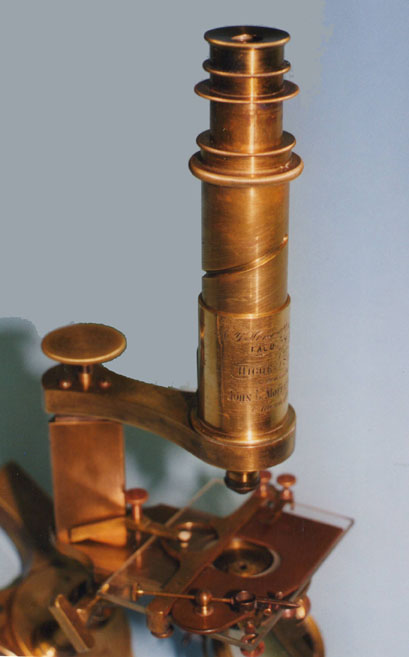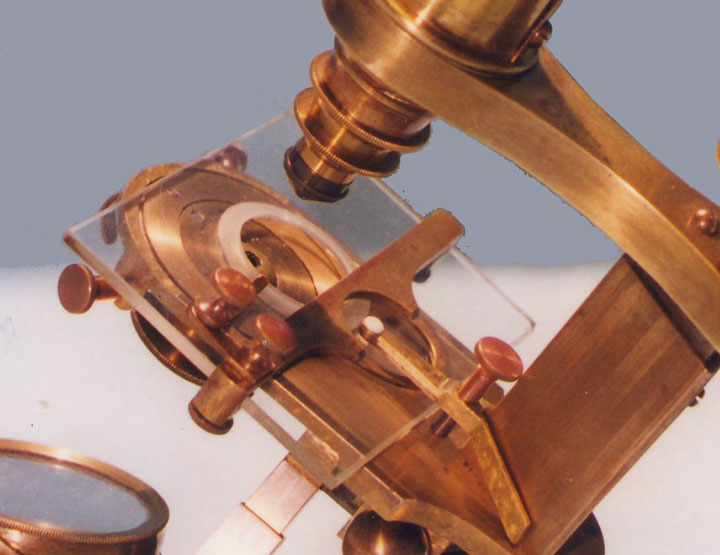GEORGE WALE'S MICROSCOPE OF 1877
SIGNED ON THE FOOT: GEO. WALE PAT'D JUNE 6 1876
AND INSCRIBED ON THE TUBE: N.Y. Homo. Med.
College, FACULTY PRIZE, for, HIGHEST
STANDING, awarded to, John L. Moffat B.S. M.D.,
March 8th 1877
SERIAL NUMBER: none
MODEL: unknown
Please Click On Any Picture for a
Larger Version



DESCRIPTION: This George Wale
microscope, (unfortunately no longer in my collection), incorporates
features seen in the
quoted U.S. patent number 178391. Its coarse focus is by a
spiral groove on the optical tube. This groove is machined in a 'V'
shaped channel and the pin which registers in this groove is also
V-shaped and spring-loaded; this leads to very smooth and concentric
operation, quite better than cruder examples of this type of focusing
mechanism seen on cheaper European microscopes of the nineteenth
century. A draw tube is present. The fine focus is the one shown in his
U.S.
patent 178391, and is similar to the continental pillar focus
common at the time; the fine focus bar is a triangular-shaped fitting,
riding inside the triangular pillar. The substage diaphragm is also the
one shown in the patent, and the same found on his famous 'New Working
Microscope' a copy of which is also to be seen on this site. Unlike the
diaphragm on the New Working Microscope, the entire diaphragm assembly
on this Wale microscope attaches via a centerable 'bayonet' fitting and
catch under the stage; a similar method of attaching substage
accessories was used by the English Maker J.B. Dancer. In contrast to
the fitting on this microscope, the fitting on the New Working ('Wale
Limb')Microscope is permanently attached to the
underside of the stage. The microscope pictured here has a gliding
stage, the type invented by Joseph Zentmayer but this one is made of
mainly of glass with a brass fitting held on to the glass by knobs on each side. The
brass fitting contains a circular cutout. The tip
of a pressure fitting rides in this cutout, holding the glass plate in placene; this fitting has adjustable
pressure. This type of stage was very popular with physicians because
it allows free movement of the slide in a controlled manner, yet allows
it to remain whereever moved without slipping even when the microscope
is inclined. This type of stage, invented by Joseph Zentmayer, was
supplied with Zentmayer's early 'Grand American' microscopes.
Zentmayer's was mainly made of brass and rode on two brass rails; the
glass version, seen here, and also on other maker's scopes, rests on a
rail which circles the entire stage. Bausch and lomb used a
modification of this design and it is also seen on the Beck
'Pathological' stand, as well as the Beck 'Ideal' model as an option. The plano-concave substage mirror is on tailpiece
which can move in the coronal plane and the mirror assembly can also
move up or down the tailpiece. The inclination joint above the two
short pillars has adjustable tension via a T-shaped knob. The pillars
rest on a circular plate which can rotate on the foot 180 degrees to
allow greater stability when inclined. Accessories still with the stand
include the substage diaphragm, two objectives, two oculars, a simple Beale-type
camera lucida, and a stage forceps slide which has a semicircular cutout to allow transmitted lighting. The slide portion of the stage forceps is made of wood.
Slide-based stage forceps were also made by Bausch & Lomb, but
theirs were mounted on a solid metal slide (see the Physician's
Microscope also on this site for an example).
HISTORY OF GEORGE WALE MICROSCOPES
George Wale (1840-c.1903) was born in New York City in September 1840, and was the son of a 'pianoforte maker'. Wale formed a partnership with Richard Morrison about 1864 but by 1871 this partnership dissolved and Wale was working with Henry Hawkins at the Stevens Institute of Technology. In 1874 the partnership ended but Wale continued to work with the Stevens Institute as 'George Wale & Company until 1878. Following that, he became associated with the Industrial Publication Company. He likely stopped producing microscopes in 1880 when his microscope business was apparently bought out by Bausch & Lomb, but he continued to make various optical instruments through at least 1902. He left New Jersey for upstate New York about 1896. He died sometime between 1902 and 1904. Wale was an innovator and made many types of optical instruments in addition to microscopes. George's cousin, William Wales was an optician born in England who moved to the USA. William was best known mainly as a maker of objectives. William's objectives were of high quality and were supplied by many American microscope makers including Walter Bulloch, and his cousin George.
George Wale's innovations
included the substage diaphragm found here, the rotation on a horseshoe
foot, and in 1879, his 'New Working Microscope' which
inclined by a radial slot and was quite inexpensive. This 'radial'
feature was copied by many makers including Swift and Ross, and also by
Bausch & Lomb which took over his business in 1880. The Ross
version was very complicated and was known as the 'Wenham Radial.'
Bausch & Lomb's version became known as the 'American
Concentric.' One of Swift's
models, also seen on this site, was closer in general form to
the original, although of much higher quality construction with the
'radial' slot finely machined. Later, in the 20th century, Swift used
this radial inclination on a more modern stand also seen on this site.
For a discussion of the history of the Prize Microscopes
given out by the N.Y. Homeopathic Medical College (later called Flower
and Fifth and later the New York Medical College), please see the article
by Alan Wisner on his site here.


